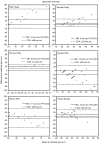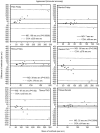Intraexaminer repeatability and agreement in stereoacuity measurements made in young adults
- PMID: 25938059
- PMCID: PMC4413594
- DOI: 10.3980/j.issn.2222-3959.2015.02.29
Intraexaminer repeatability and agreement in stereoacuity measurements made in young adults
Abstract
Aim: To determine the repeatability and agreement of stereoacuity measurements made using some of the most widely used clinical tests: Frisby, TNO, Randot and Titmus.
Methods: Stereoacuity was measured in two different sessions separated by a time interval of at least 24h but no longer than 1wk in 74 subjects of mean age 20.6y using the four methods. The study participants were divided into two groups: subjects with normal binocular vision and subjects with abnormal binocular vision.
Results: Best repeatability was shown by the Frisby and Titmus [coefficient of repeatability (COR): ±13 and ±12s arc respectively] in the subjects with normal binocular vision though a clear ceiling effect was noted. In the subjects with abnormal binocular vision, best repeatability was shown by the Frisby (COR: ±69s arc) and Randot (COR: ±72s arc). In both groups, the TNO test showed poorest agreement with the other tests.
Conclusion: The repeatability of stereoacuity measures was low in subjects with poor binocular vision yet fairly good in subjects with normal binocular vision with the exception of the TNO test. The reduced agreement detected between the tests indicates they cannot be used interchangeably.
Keywords: agreement; repeatability; stereoacuity; stereopsis.
Figures





Similar articles
-
Validity of the Titmus and Randot circles tasks in children with known binocular vision disorders.J AAPOS. 2003 Oct;7(5):333-8. doi: 10.1016/s1091-8531(03)00170-8. J AAPOS. 2003. PMID: 14566315
-
Maximum angle of horizontal strabismus consistent with true stereopsis.J AAPOS. 2004 Feb;8(1):28-34. doi: 10.1016/j.jaapos.2003.08.010. J AAPOS. 2004. PMID: 14970796
-
Test retest variability in stereoacuity measurements.Strabismus. 2023 Sep;31(3):188-196. doi: 10.1080/09273972.2023.2252853. Epub 2023 Sep 13. Strabismus. 2023. PMID: 37705215
-
Normative Values for Near and Distance Clinical Tests of Stereoacuity.Strabismus. 2016 Dec;24(4):169-172. doi: 10.1080/09273972.2016.1242636. Strabismus. 2016. PMID: 27929725
-
Stereoacuity norms for school-age children using the Frisby stereotest.J AAPOS. 2013 Dec;17(6):582-7. doi: 10.1016/j.jaapos.2013.08.012. J AAPOS. 2013. PMID: 24321423
Cited by
-
ASTEROID: A New Clinical Stereotest on an Autostereo 3D Tablet.Transl Vis Sci Technol. 2019 Feb 28;8(1):25. doi: 10.1167/tvst.8.1.25. eCollection 2019 Jan. Transl Vis Sci Technol. 2019. PMID: 30834173 Free PMC article.
-
Stereopsis in Early Diabetic Retinopathy.Clin Optom (Auckl). 2020 Jan 10;12:1-7. doi: 10.2147/OPTO.S232312. eCollection 2020. Clin Optom (Auckl). 2020. PMID: 32021531 Free PMC article.
-
An Evaluation of the Agreement Between a Computerized Stereoscopic Game Test and the TNO Stereoacuity Test.Clin Optom (Auckl). 2021 Jul 5;13:181-190. doi: 10.2147/OPTO.S308445. eCollection 2021. Clin Optom (Auckl). 2021. PMID: 34267572 Free PMC article.
-
The size-distance scaling of real objects and afterimages is equivalent in typical but not reduced visual environments.Exp Brain Res. 2025 May 12;243(6):144. doi: 10.1007/s00221-025-07064-1. Exp Brain Res. 2025. PMID: 40350527 Free PMC article.
-
Altered visual functions, macular ganglion cell and papillary retinal nerve fiber layer thickness in early-treated adult PKU patients.Mol Genet Metab Rep. 2020 Sep 22;25:100649. doi: 10.1016/j.ymgmr.2020.100649. eCollection 2020 Dec. Mol Genet Metab Rep. 2020. PMID: 32995291 Free PMC article.
References
-
- Kuang T, Hsu W, Chou CK, Tsai SY, Chou P. Impact of stereopsis on quality of life. Eye (Lond) 2005;19(5):540–545. - PubMed
-
- Fawcett SL, Wang YZ, Birch EE. The critical period for susceptibility of human stereopsis. Invest Ophthalmol Vis Sci. 2005;46(2):521–525. - PubMed
-
- Saladin JJ. Stereopsis from a performance perspective. Optom Vis Sci. 2005;82(3):186–205. - PubMed
-
- Richardson SR, Wright CM, Hrisos S, Buck D, Clarke MP. Stereoacuity in unilateral visual impairment detected at preschool screening: outcomes from a randomized controlled trial. Invest Ophthalmol Vis Sci. 2005;46(1):150–154. - PubMed
LinkOut - more resources
Full Text Sources
